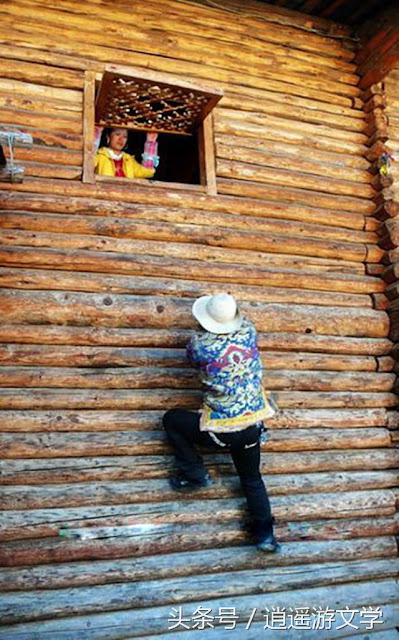Introduction
This article tells the origin of the Na people in Yunnan and Sichuan. In different ancient times, their ancestors were called Maoniu (髦牛), Bailang (白狼) or Muosa (摩沙) by the Han Chinese.However, the Mosuo and Nashi/Nakhi people call themselves Na people. The word 'Na' means big and 'Shi' means people.
Homeland
The Nashi people are part of the Sino-Tibetan people. Their current homeland is in northwestern Yunnan around the Lijiang (麗江) region.
Original homeland
Their original homeland is in the Yalong River basin, a tributary of the Yangtze River in southwestern Sichuan. |
| Migration path in red (inset-Nashi people) |
During early 4th century AD, the Nashi, a subgroup of the Naic people, migrated from Yalong River and annexed modern-day Lijiang city in Yunnan. The natives of Lijiang was called Pulu (濮盧) who were most probably the native Austroasiatic tribes of Yunnan.
The Lolo-Yi people who migrated from northeastern Yunnan acknowledge that the Naic people were the natives in those regions.
Naic Kingdom
The Naic people had a kingdom called Bailang (白狼) around Batang (巴塘) county in western Garze Prefecture in Sichuan around 74 AD (Eastern Han dynasty) when they presented a gift of Na poems written in Dongba script to the Han emperor. |
| Two Bailang artefacts found in ancient Bailang kingdom |
Tea horse road
Lijiang city was an important stop along the famous Ancient Tea Horse Road where tea planted in Yunnan were carried in big tea baggage by the caravan of horses and sold to traders in Tibet, India and Europe.
 |
| Ancient tea horse caravan |
Naic culture
The Mosuo follow a matrilineal society where the women are the head of households.
A woman can have several temporary boyfriends who will climb into their windows for the night and father her children. The Na people call this the 'walking marriage' where the different fathers with the same mother don't stay in the same house with the mother and children.
However, the Nashi subgroup in Lijiang city have changed from matrilineal to patrilineal sometimes in the past.
The Nashi music and musical instruments are heavily borrowed from the Han Chinese.
 |
| Nashi playing band |
Nashi festivals
The Nashi's most important festival is the Sanduo Festival, in memory of Sanduo the war god, in which a temple was built on Jade Dragon Snow Mountain in Lijiang in 784 AD during the Nanzhao kingdom.
Nashi's legend stated that Sanduo was an aid to Azong, the last Nashi ruler, before the Mongol conquest of Yunnan in 1253 AD.
 |
| Sanduo the war god |
Religion and writing script
Their native hieroglyphic script was called Dongba which is still used in religious activities.
The Na people practice the shamanistic Dongba religion with influences from Tibetan Buddhism and also Daoism. The Dongba religion is believed to originate from the Tibetan Bon religion whose founder has a similar name Tonpa Shenrab.
 |
| Dongba priests |
Naic subgroups
The Naic branch of Sino-Tibetan includes the following subgroups:
- Nashi/Naxi (納西) in Lijiang prefecture of Yunnan
- Na/Nare/Mosuo (摩梭) in Yongning town and Lugu Lake in northwestern Yunnan.
- Namuyi/Namuzi in southwestern Sichuan
- Shixing/Xumi in southwestern Sichuan
 |
| Distribution of the Naic people |
 |
| Namuyi |
The Namuyi and Shixing people are the descendants of their common proto-Naic ancestors in their original homeland before the ancestors of Mosuo & Naxi people migrated further south along the Yalong River to Yunnan.
Note: The 'Mosuo' who speak Laze/Lare in Muli county in southwestern Sichuan are actually ethnic Mongols.
They were the descendants of the Mongol army who invaded China during the 13th century AD. They established an army base south of Lugu Lake and later adopted the Mosuo language after staying there for a long time. They shouldn't be confused with the real Mosuo people living around Lugu Lake.
Closest ethnic relative
Initially Sun Hongkai, a Chinese linguist, put some but not all of the Naic subgroups under Southern Qiangic.
However, the Naic people is a separate branch but it's closest ethnic relative seems to be the Qiangic people.
The latest tentative classification by western linguists Jacques & Michaud is as follows but this might change in the future.
If this relationship is true, then that implies that the Naic people came from upper Min river basin where the proto-Naic-Qiangic people live before reaching Yalong river basin.
The Ersuish people might possibly be Naic people but their culture of worshipping white color suggested a closer relationship to the Qiangic people instead.
Conclusion
The Nashi and Mosuo are the natives of Yalong River basin in Sichuan province. They form a main branch of the Sino-Tibetan people called Naic.Related links
Ethnic origin of Sino-Tibetan people- Sons of Heaven, Brothers of Nature: The Naxi of Southwest China. By Pedro Ceinos Arcones
- State and Ethnicity in China's Southwest. By Xiaolin Guo.
- The Namuyi: Linguistic and Cultural Features. Libu Lakhi, Brook Hefright and Kevin Stuart
- "Approaching the historical phonology of three highly eroded Sino-Tibetan languages: Naxi, Na and Laze." By Jacques, Guillaume, and Alexis Michaud. 2011.
- https://kknews.cc/zh-my/culture/l4vname.html
- https://kknews.cc/culture/kxnky2v.html
- https://kknews.cc/culture/o864p4m.html
- https://kknews.cc/culture/lxq6xng.html
- https://kknews.cc/culture/p824yq2.html
- https://www.yun519.net/article.php?id=126
- https://kknews.cc/zh-my/history/v3ooq4a.html
- https://kknews.cc/history/eppby54.html
- https://kknews.cc/history/kl23j28.html
- https://kknews.cc/history/3oaqypy.html
- https://kknews.cc/culture/o6my5.html
- https://kknews.cc/culture/3m4xboy.html
- https://kknews.cc/travel/3b9n3o.html
- https://www.gokunming.com/en/blog/item/4134/exploring-the-cultural-m%C3%A9lange-of-naxi-religion






Comments
Post a Comment